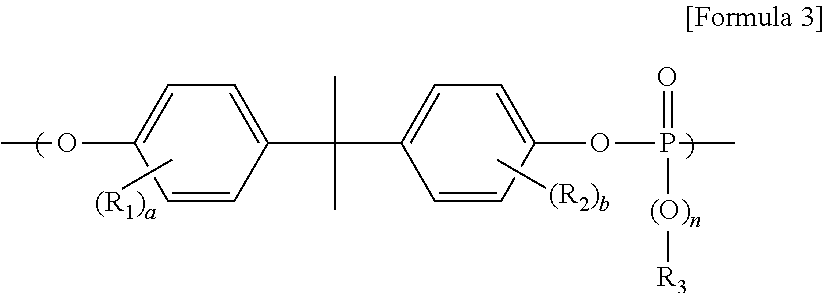Polycarbonate and Method of Preparing the Same
- Summary
- Abstract
- Description
- Claims
- Application Information
AI Technical Summary
Benefits of technology
Problems solved by technology
Method used
Image
Examples
example 1
[0068]2.85 kg of 2,2-bis(4-hydroxyphenyl)propane (bisphenol A), 0.12 kg of 4,4′-biphenol, 2.78 kg of diphenyl carbonate, 0.21 kg of diphenyl phenylphosphonate, and 150 ppb of KOH (based on 1 mol of bisphenol A) were sequentially added to a reactor, and oxygen in the reactor was removed using nitrogen. The reactor was heated to 160° C. and then to 190° C., at which temperature the reaction was performed for 6 hours. After 6 hours, the reactor was further heated to 210° C. and maintained at 100 Torr for 1 hour. The reactor was heated to 260° C. and maintained at 20 Torr for 1 hour, and then was decompressed to 0.5 Torr and maintained for 1 hour. Then, 0.03 phr of antioxidants and 0.05 phr of phosphorous heat stabilizers were added to the melt polymer and mixed to form a uniform mixture for about 10 minutes (phosphorus content: 1.2%).
example 2
[0069]2.70 kg of 2,2-bis(4-hydroxyphenyl)propane (bisphenol A), 0.25 kg of 4,4′-biphenol, 2.63 kg of diphenyl carbonate, 0.42 kg of diphenyl phenylphosphonate, and 150 ppb of KOH (based on 1 mol of bisphenol A) were sequentially added to a reactor, and oxygen in the reactor was removed using nitrogen. Then, polymerization was performed in the same manner as in Example 1 (phosphorus content: 2.3%)
example 3
[0070]2.70 kg of 2,2-bis(4-hydroxyphenyl)propane (bisphenol A), 0.25 kg of 4,4′-biphenol, 2.34 kg of diphenyl carbonate, 0.85 kg of diphenyl phenylphosphonate, and 150 ppb of KOH (based on 1 mol of bisphenol A) were sequentially added to a reactor, and oxygen in the reactor was removed using nitrogen. Then, polymerization was performed in the same manner as in Example 1 (phosphorus content: 2.3%).
PUM
| Property | Measurement | Unit |
|---|---|---|
| Temperature | aaaaa | aaaaa |
| Length | aaaaa | aaaaa |
| Molar density | aaaaa | aaaaa |
Abstract
Description
Claims
Application Information
 Login to View More
Login to View More - R&D Engineer
- R&D Manager
- IP Professional
- Industry Leading Data Capabilities
- Powerful AI technology
- Patent DNA Extraction
Browse by: Latest US Patents, China's latest patents, Technical Efficacy Thesaurus, Application Domain, Technology Topic, Popular Technical Reports.
© 2024 PatSnap. All rights reserved.Legal|Privacy policy|Modern Slavery Act Transparency Statement|Sitemap|About US| Contact US: help@patsnap.com










